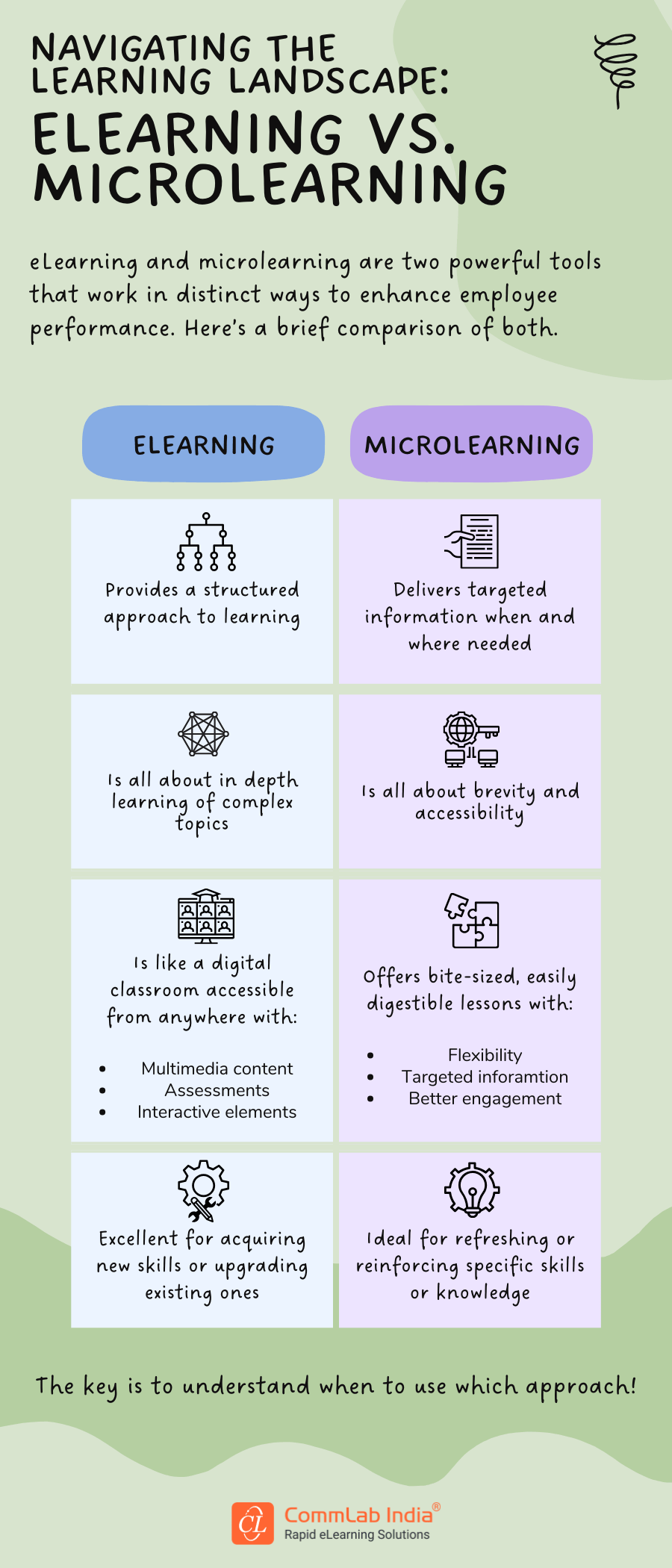Understanding the Difference Between eLearning and Microlearning [Infographic]
![Understanding the Difference Between eLearning and Microlearning [Infographic] Understanding the Difference Between eLearning and Microlearning [Infographic]](https://blog.commlabindia.com/hubfs/blogs/difference-elearning-microlearning-info.jpg)
Here’s a scenario for you. Imagine you're hungry. So would you rather:
Opt for a massive feast: A towering stack of patties, a mountain of fries, sandwiches, pizza, soft drinks, and more? You conquer it slowly, savoring each bite, but it takes a good hour.
Snack on a mini meal: Bite-sized sliders, bursting with flavor, just enough to satisfy your immediate hunger. You can grab one on the go, munch between tasks, and easily fit several into your day.
What would you choose?
Both eLearning and microlearning are similar approaches to learning, but they cater to different learning appetites.
In this blog, we’ll break down the differences for you and then help you understand the use cases of each in corporate training. So without any delay, let’s start.
eLearning vs Microlearning
→ Free eBook: Instructional Design Strategies to Design Engaging eLearning Courses
Use Cases of eLearning
Onboarding and Orientation
Imagine seamlessly integrating new hires into your company's fabric without the hassle of exhaustive in-person sessions. With eLearning modules, you can effortlessly introduce your recruits to your company culture, policies, procedures, and tools. New employees learn at their own pace, ensuring a smooth transition and easy access to crucial information whenever they need it.
Product and Software Training
Are you tired of handing out bulky manuals and text-based guides to your employees because that hardly makes a dent in understanding complex software? Well, eLearning offers you a variety of ways to make your product and software training more interactive and impactful. You can leverage eLearning interactivities, simulations, multimedia elements, demonstrations, etc.
Compliance Training
Ensuring compliance training that stays with the employees in practice can be tough. However, with eLearning, it doesn't have to be a headache. eLearning modules allow you to deliver consistent and standardized mandatory training. It can be on a variety of topics, such as ethics, harassment, and safety. So you don’t have to worry about legal issues and accidents.
Use Cases of Microlearning
Microlearning, the delivery of focused learning in bite-sized chunks, is gaining traction in corporate training thanks to its effectiveness in today's busy and dispersed workforces. Here are some key use cases for microlearning:
Onboarding
Microlearning is an effective approach to providing new employees with relevant, desired information without overwhelming them. That’s right! New hires can take up short, targeted modules right when they need it. They can navigate the company email system, policies, procedures, organization hierarchy, and other company aspects to ensure they fit well in the company system.
Just-in-Time Support
Whether it’s the new employees or the existing ones, you can easily leverage microlearning to offer just-in-time support. Employees can get quick refreshers on product updates, policy updates, safety procedures, etc. This helps keep everyone sharp and on the ball.
Upskilling and Reskilling
In the ever-evolving business landscape, staying ahead is the name of the game. With microlearning, your team can learn about emerging technologies, new software features, the latest sales techniques, etc., at their own pace. Microlearning makes learning a seamless part of their daily routine, not a tedious task.
Performance Support
Beating the forgetting curve can be tricky. Information, when not put into practice can often lie dormant and when a person needs to access this information, it gets really difficult to recall it. This can have a negative impact on the performance and confidence of the employees. In such situations, microlearning can be a blessing. The short, concise modules enable employees to quickly revisit the desired information and continue with their tasks.
In The End!
Each approach has its own benefits and use cases. It depends on the learning requirement and target audience when it comes to selecting the right training method. Now you have a clear idea about the differences between eLearning and microlearning, it’ll be easier for you to understand the nuances of your training and pick the training method that aligns well with it. Regardless of the training method, having a thorough knowledge of instructional design strategies is essential to designing high-impact, engaging training modules. So here’s a free eBook for the same. Check it out now!





![How to Create Quick Microlearning Courses using Rapid eLearning [Infographic]](https://blog.commlabindia.com/hubfs/Imported_Blog_Media/microlearning-development-rapid-elearning-info.jpg)

